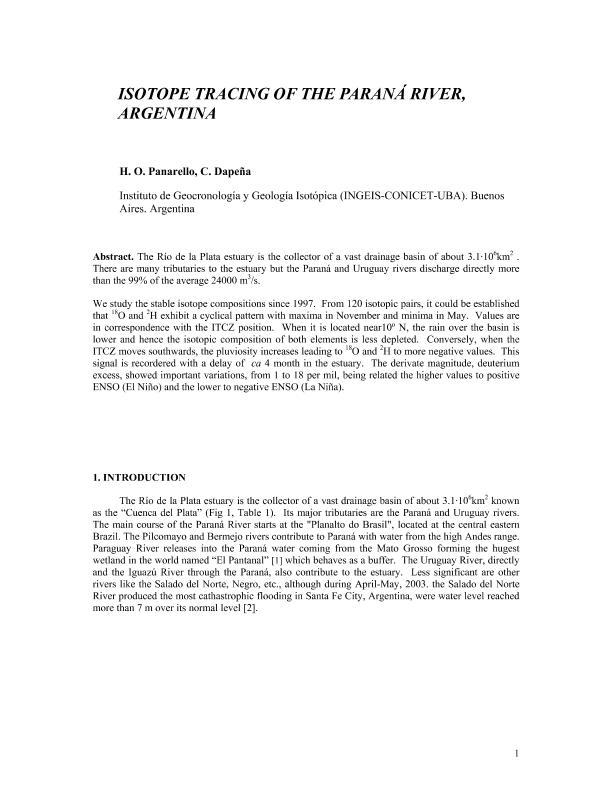Mostrar el registro sencillo del ítem
dc.contributor.author
Panarello, Hector Osvaldo

dc.contributor.author
Dapeña, Cristina

dc.date.available
2017-12-27T19:36:24Z
dc.date.issued
2012-05
dc.identifier.citation
Panarello, Hector Osvaldo; Dapeña, Cristina; Isotope Tracing of the Parana River, Argentina; International Atomic Energy Agency; IAEA Tecdoc; 1673; 5-2012; 1-20
dc.identifier.issn
1011-4289
dc.identifier.uri
http://hdl.handle.net/11336/31710
dc.description.abstract
The Rio de la Plata estuary is the collector of a vast drainage basin of about 3.1x106 km2 . There are many tributaries to the estuary but the Parana and Uruguay rivers directly discharge more than 99% of the average discharge (24 000 m3/s). The stable isotope composition of water in this estuary has been monitored since 1997. From 120 isotopic pairs, it could be established that 18O and 2H exhibit a cyclical pattern with a maximum in November and a minimum in May. Values correspond to the ITCZ position. When it is located near 8oN, the amount of precipitation over the basin decreases and hence the isotopic composition of both elements is more positive. Conversely, when the ITCZ moves southward, the pluviosity increases, leading to more negative δ18O and δ2H values. This isotopic signal is recordered with a delay of ca 4 month in the estuary. The derivate magnitude, deuterium excess, showed important variations, from 1 to δ18 per mille, with the higher values being related to positive ENSO (El Nino) phases and lower values to negative ENSO (La Nina). Despite the interactions with groundwater and physical processes along ca. 2800 km, the Parana River still reflects at its mouth all these climatic phenomena that control the δ2H and δ18O contents at its catchment areas.
dc.format
application/pdf
dc.language.iso
eng
dc.publisher
International Atomic Energy Agency
dc.rights
info:eu-repo/semantics/openAccess
dc.rights.uri
https://creativecommons.org/licenses/by-nc-sa/2.5/ar/
dc.subject
Enso Phenomena
dc.subject
Deuterium Excess
dc.subject
Deuterium Oxygen-18
dc.subject
Tritium
dc.subject.classification
Química Analítica

dc.subject.classification
Ciencias Químicas

dc.subject.classification
CIENCIAS NATURALES Y EXACTAS

dc.title
Isotope Tracing of the Parana River, Argentina
dc.type
info:eu-repo/semantics/article
dc.type
info:ar-repo/semantics/artículo
dc.type
info:eu-repo/semantics/publishedVersion
dc.date.updated
2017-07-13T18:30:57Z
dc.journal.number
1673
dc.journal.pagination
1-20
dc.journal.pais
Austria

dc.journal.ciudad
Viena
dc.description.fil
Fil: Panarello, Hector Osvaldo. Consejo Nacional de Investigaciones Científicas y Técnicas. Oficina de Coordinación Administrativa Ciudad Universitaria. Instituto de Geocronología y Geología Isotopica. Universidad de Buenos Aires. Facultad de Ciencias Exactas y Naturales. Instituto de Geocronología y Geología Isotópica; Argentina
dc.description.fil
Fil: Dapeña, Cristina. Consejo Nacional de Investigaciones Científicas y Técnicas. Oficina de Coordinación Administrativa Ciudad Universitaria. Instituto de Geocronología y Geología Isotopica. Universidad de Buenos Aires. Facultad de Ciencias Exactas y Naturales. Instituto de Geocronología y Geología Isotópica; Argentina
dc.journal.title
IAEA Tecdoc
dc.relation.alternativeid
info:eu-repo/semantics/altIdentifier/url/https://inis.iaea.org/search/search.aspx?orig_q=RN:43048664
Archivos asociados
